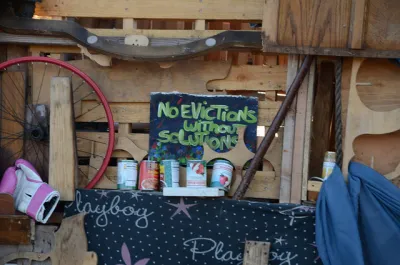A survey of renters' housing history in Milwaukee could completely change what we know about eviction in the United States.

A study spearheaded by Harvard sociologist Matthew Desmond, author of Evicted: Poverty and Profit in the American City, indicates that eviction may be far more common than previously thought.
For one, FiveThirtyEight reports, the Milwaukee Area Renters Study (MARS) found that formal evictions—those involving a court order—accounted for only 24 percent of all forced moves in the region. By contrast, informal evictions—in which, for example, landlords "give a tenant $200 to move out by Thursday" or simply "take the door off"—made up 48 percent.
There's more—a lot more:
Desmond’s follow-up research using MARS data has found a strong connection between eviction and subsequent residential instability, even after factoring in the tenant’s income and race. Eviction is linked to substandard housing conditions. And eviction also has serious negative health consequences, particularly for children.
Eviction also has a racial and gender bias: “Among renters, over one in five black women report having been evicted sometime in their adult life,” Desmond has found.
While the study was limited to the Milwaukee area, it yielded so much more information than current federal practices that the Census Bureau is hoping to incorporate it into the biennial housing survey. In fact, FiveThirtyEight writes that it "may be the first rigorous, detailed look at eviction in a major city."
Its success can be attributed to its careful design. In interviews with more than a thousand local tenants over three years, researchers avoided language with specific formal connotations—like “eviction”—and instead asked people to describe their actual experiences.
The MARS researchers found that when people were forced to move, they often didn’t see it as an eviction. So instead of just asking, “Have you ever been evicted?” the MARS survey posed a roster of questions about a tenant’s housing history — when and where they had lived and why they left. This “moving module” was the centerpiece of the MARS study.
FULL STORY: How We Undercounted Evictions By Asking The Wrong Questions

National Parks Layoffs Will Cause Communities to Lose Billions
Thousands of essential park workers were laid off this week, just before the busy spring break season.

Retro-silient?: America’s First “Eco-burb,” The Woodlands Turns 50
A master-planned community north of Houston offers lessons on green infrastructure and resilient design, but falls short of its founder’s lofty affordability and walkability goals.

Delivering for America Plan Will Downgrade Mail Service in at Least 49.5 Percent of Zip Codes
Republican and Democrat lawmakers criticize the plan for its disproportionate negative impact on rural communities.

Test News Post 1
This is a summary

Test News Headline 46
Test for the image on the front page.

Balancing Bombs and Butterflies: How the National Guard Protects a Rare Species
The National Guard at Fort Indiantown Gap uses GIS technology and land management strategies to balance military training with conservation efforts, ensuring the survival of the rare eastern regal fritillary butterfly.
Urban Design for Planners 1: Software Tools
This six-course series explores essential urban design concepts using open source software and equips planners with the tools they need to participate fully in the urban design process.
Planning for Universal Design
Learn the tools for implementing Universal Design in planning regulations.
EMC Planning Group, Inc.
Planetizen
Planetizen
Mpact (formerly Rail~Volution)
Great Falls Development Authority, Inc.
HUDs Office of Policy Development and Research
NYU Wagner Graduate School of Public Service





























